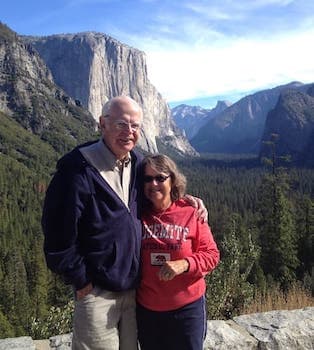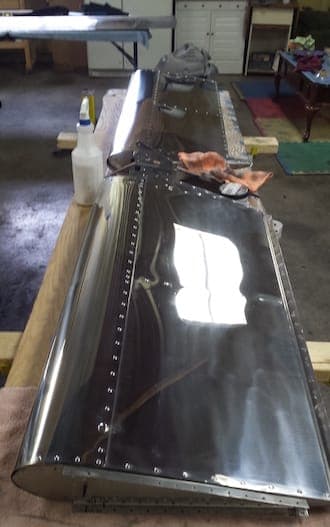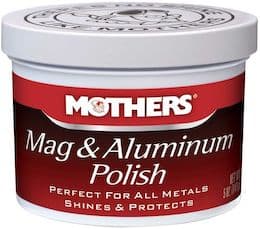
-----
Sanding & polishing aluminum sheet & tubing
Q. Hi Folks,
I am a furniture maker, working with a lot of aluminum lately.
Our first process was taking aluminum rectangular tube stock and plate with a mill finish, and sanding it (forever) through the grits 60-320, then Maroon, Green, and finally White Festool scotchbrite type pads to get this super matte perfectly even surface with no graining.
This takes forever. Especially getting the mill marks off.
We did this for a lot of pieces and the guys hate it.
The next thing that I did was bring it to a grinding place. Basically they ran the parts through a Timesaver, and grained everything to about 120 grit. This was great in getting an even surface, but the graining actually is pretty deep, and we had to start again at 60 grit.
I'm looking for ideas on a better process. Getting better plate? Is there a spec from plate from the mill that is clean? For the rectangular tubing, it's just such a mess. Is this just what it takes?
One suggestion I heard was to get it grained, and then to use airway wheels and red rouge, and that should get rid of the graining?
And tricks for sanding aluminum? I tried WD40 - it leaves a filmy mess and doesn't seem to make anything work better, unless there is a specific technique that I don't know.
Thank you!
- Berkeley, California
May 27, 2025
A. Hi Rafi.
I am not sure exactly what you mean by a "super matte perfectly even finish", but polishing aluminum to a mirror finish remains a very labor intensive job as you have found. We have many threads of the subject, offering tweaks here & there, but there is no quick way to get from a rough finish to mirror smooth.
But another question I have is whether you will be doing anything to preserve that surface condition -- like clear coating or anodizing -- after you have achieved it? Most anodizing shops have the capacity to etch aluminum in sodium hydroxide or an acid like ammonium bifluoride, thereby offering both a nice matte finish and a corrosion resistant one.
If you haven't spoken to a local anodizing shop, I suggest that you visit one. They may be able to deliver exactly what you are looking for with a lot less effort.
Luck & Regards,

Ted Mooney, P.E. RET
Striving to live Aloha
finishing.com - Pine Beach, New Jersey
Ted is available for instant help
or longer-term assistance.
Q. Thanks Ted!
What I'm looking for is advice on abrasives - what type, specifics, lubricant, etc.
Sequence and process, and see if I can do things better.
I know that it's a chore, but I really want to just do the chore efficiently.
I am waxing all my pieces as well.
- Berkeley, California
May 31, 2025
A. Hi again, Rafi.
Other readers are encouraged to engage with you and try to help, but If you read the rest of this thread, and search the site for "aluminum polishing", you'll see hundreds of people with the same problem of hating the messy and very time-consuming problem of polishing aluminum.
There are apparently no silver bullets at present that will revolutionize the process, but, yes, some sequences and procedures are probably a bit better than others, and hopefully you will learn at least a trick or two to at least slightly improve the process.
Luck & Regards,

Ted Mooney, P.E. RET
Striving to live Aloha
finishing.com - Pine Beach, New Jersey
Ted is available for instant help
or longer-term assistance.
⇩ Related postings, oldest first ⇩
Q. How do I polish 6061-T6 aluminum sheet metal to a mirror finish? I have tried NUVITE compound on an orbital buffer with marginal results. I would like to buff the aluminum and eliminate the grain and scratches, the NUVITE doesn't seem to cut deep enough. Any suggestions on compound, applicators, equipment and technique?
P.S. The aluminum sheets are bare 6061 T6, no Alclad coating.
Dana Thurston- Portsmouth, New Hampshire
2002
A. Have you tried Mothers Mag & Aluminum Polish ⇦ on eBay or Amazon [affil link] ? I've had fairly good results with this.. of course, you must start off with a relatively scratch free surface to begin with. Another option you may want to consider is electropolishing, or a bright dip, both of which should probably be followed up with a very thin anodized coating.

Marc Green
anodizer - Boise, Idaho
A. We have had the same issue regarding 6061 aluminum and scratches. We also found that orbital buffing equipment was the only way to produce a finish that allowed us to buff the part to a mirror finish. Is the final result you are looking for is a buff (mirror polish) finish?
If so, we have found that red sisal wheels roughing the part before buffing on standard cotton wheels is a better and more cost effective solution. That is with our equipment (an in-line buffing "shack"). Not knowing your equipment capability I cannot offer a further solution.
Let me know.
James P. Elwellpolishing engineer - Story City, Iowa
Q. I am a journeyman carpenter in the museum/trade show/convention industry. I work with a wide variety of materials on a daily basis, all projects are custom & fairly low volume.
One of my favorite materials is aluminum, both for structural & aesthetic applications. I am not a welder, however I often grind, sand & polish what welders fabricate. I have worked for several of the largest companies in my industry for 25 years & have yet to see a sanding protocol that produces an acceptable finish in a reasonable time frame. I commonly sand 4' x 8' sheets in various thicknesses, including laminates with & without phenolic backing.
My current project is fairly typical & serves as a good example. 30 welded curved frames constructed out of 1 1/2" square aluminum tubing w/a 1/8" wall. Each frame represents approximately 34 lineal ft. of tubing. All surfaces show & the desired finish is a clearcoat over a sanded finish. Grinding usually starts @ 36 grit, 6", "Klingspore" followed by 60 grit, followed by sanding w/5" Dual Action sander, usually 80 grit "3-M" paper followed by 120 grit. The spiral DA pattern is generally acceptable for most projects. This is an extremely time consuming process & to date, no welder has come up with a procedure better than my own. I use inordinate quantities of sandpaper & grinding discs, & the entire process seems needlessly labor intensive. I like the size, weight & rpms of a pneumatic DA sander. However, they bog down under heavy loads ( I oil them regularly ) & their cfm demands are too high for most compressors. I do have help & I could be driving half a dozen DA's at the same time. The clutches also seem to wear quickly when used continuously on aluminum. I am currently using 5" electric DA's, these seem to work best since they can tolerate higher load pressure without a notable drop in rpms. The best product I have used to date is Grinders Grease in tube/stick form. This greatly speeds up all machining evolutions ( 5 minutes vs 30 ) & I use a lot less grinding wheels & sanding discs ( 1 vs 5 ). I am contemplating using a variable speed polisher for sanding, but I'm not impressed w/their rpms ( 3,000 to 6,000 ) Using grinders grease on my grinding wheels & sanding discs not only extends their life but also allows me to use much higher load pressure. The faster my rpms, the higher my load pressure, the better my results. My last idea is to use a small hand grinder married to a sanding disc ( 10,000 rpms with substantial torque ).
Whatever I decide to try, my employer signs the PO, so any help & or suggestions would be greatly appreciated by a carpenter wannabe metal finisher. I would very much like to present an intelligent idea to improve these procedures, however I'm fresh out & frustrated.
Thank you for your time and consideration.
woodshop - Nashville, Tennessee USA
2005
A. Have you ever consulted a manufacturer of abrasive products? You know there have been a lot of changes in abrasives and equip. You might like to look at non-woven products or some of the newer flap discs. There are some discs with holes in them to eliminate loading problems. I suspect you are going to have to do a lot of R & D on your own. Then again, you have procedures in place to fall back on.

AF Kenton
retired business owner - Hatboro, Pennsylvania
A. Have you tried using zirconium pads or disks? I use 80 and 120 grit zirc belts on my Timesaver Sander, and they produce a high-quality finish in short order, and last a long time. I believe Kling-spore has these products.
Robby
mfgr. - Garland, Texas, U.S.A
2007
Q. I am finishing sheets of 5052 aluminum with an random orbital sander. First pass is with 60 grit sandpaper, second pass is with 100 grit. I am trying to achieve a rough brushed look with no discernable grain or pattern. This works very well for me but sometimes I am left with some shiny marks in large patches or in fine spring shaped spiral patterns that I am guessing are left by the sander. These marks become visible in the 100 grit pass, and more visible if I try to step up to a finer grit. Sometimes the marks don't become apparent until the sheets are post coated with lacquer. Does anybody have any idea how to avoid the shiny spiral marks, or remove them?
thank you.
studio - Oakland, California, United States
2006
A. I think--magic word is think-- that the finer sandpaper is crosswise to some of the deeper gouges from the first paper and parallel to same. The crosswise areas will tend to be smoother or more polished or less rough while the parallel areas will basically remain coarse and thus show considerably more.
You might try using only one paper of average grit and see what happens.
Another possibility is to put a new fine grit paper on and re-sand it a second time. The paper fills up.
If it is an air sander, you might try wet and dry paper and sand wet.
(rinse very well if you do)
- Navarre, Florida
A. Try using dedicated sander with oil resistant rubber pad or felt pad using mineral spirits ⇦ on eBay or Amazon [affil link] as lubricant with wet dry paper. Shiny spots can be from burnishing from clogged paper. Also Stearated paper and air hose also(dry) can be used with blowing off paper regularly. Also try Mirka screen abrasives too(dry) with vac sander and/or compressed air cleaning as above.
Norm Stavin- Amagansett, New York
2007

Q. I have used airway wheels
⇦ on
eBay
or
Amazon [affil link]
and polishing buffers of 100% cotton and even if I remove all the milling I have small areas of burnishing...how can this be removed? I'm doing a full polish on my new kit airplane and I can't afford a mistake. This burnishing resembles cloudy areas.
Jim in Texas
- Wichita Falls,Texas
November 7, 2016
"You'll do just fine on your very first try!"^"Practice makes perfect."
Although I'm no polishing expert, I do know that book knowledge won't get you all the way. You should get some scrap material and practice on it rather than starting on an item where you can't afford a mistake.
Letter 800 is about polishing aluminum, and discusses in good length the many things that can go wrong including what causes such haze. Good luck.
Regards,

Ted Mooney, P.E. RET
Striving to live Aloha
finishing.com - Pine Beach, New Jersey
Ted is available for instant help
or longer-term assistance.
Q, A, or Comment on THIS thread -or- Start a NEW Thread
